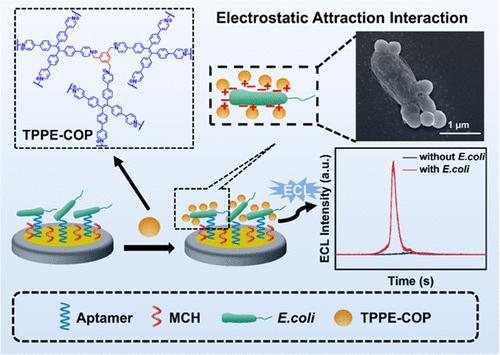当前位置:
X-MOL 学术
›
Anal. Chem.
›
论文详情
Our official English website, www.x-mol.net, welcomes your
feedback! (Note: you will need to create a separate account there.)
Tetraphenylethene-Based Covalent Organic Polymers with Aggregation-Induced Electrochemiluminescence for Highly Sensitive Bacterial Biosensors
Analytical Chemistry ( IF 6.7 ) Pub Date : 2024-11-12 , DOI: 10.1021/acs.analchem.4c03249 Ziqi Lian, Changmao Li, Yu Wang, Li Tan, Meng Yu, Ling Xiao, Linli He, Wenjing Gao, Yuchan Liu, Ying Ma, Jianqiang Hu, Xiang Luo, Aiqing Li
Analytical Chemistry ( IF 6.7 ) Pub Date : 2024-11-12 , DOI: 10.1021/acs.analchem.4c03249 Ziqi Lian, Changmao Li, Yu Wang, Li Tan, Meng Yu, Ling Xiao, Linli He, Wenjing Gao, Yuchan Liu, Ying Ma, Jianqiang Hu, Xiang Luo, Aiqing Li

|
Tetraphenylethene (TPE), which usually serves as aggregation-induced emission and aggregation-induced electrochemiluminescence fluorophores, has been widely applied in fabricating fluorescent nanomaterials and biosensors. However, it is still a tremendous challenge to prepare well-controlled TPE aggregates with strong fluorescence (FL) and electrochemiluminescence (ECL). In this study, we constructed a bacterial ECL biosensing platform with high sensitivity based on TPE-based covalent organic polymer (COP) nanoparticles synthesized by a simple Menschutkin reaction strategy to employ bromide group-carrying molecules and 1,1,2,2-tetrakis(4-(pyridine-4-yl)phenyl)ethene as the cross-linking agent and the emissive moiety, respectively. The ECL Escherichia coli biosensor had high sensitivity, a low limit of detection (0.19 CFU mL–1), a wide linear range (1 × 102–5 × 106 CFU mL–1), and good selectivity. The excellent properties of the bacterial biosensor could be attributed to the uniform spherical COP nanoparticles with enhanced FL and ECL signals, the maximal ECL efficiency of which was 8.4-fold higher than that of the typical tris(bipyridine) ruthenium(II) emitter. The FL and ECL intensities of the TPE-based COP nanoparticles could be adjusted by varying bromide group-carrying molecules and thus regulating their energy gap between highest occupied molecular orbital (HOMO) and lowest unoccupied molecular orbital (LUMO) orbitals. The TPE-based COP nanoparticles with strong FL and ECL intensities pave a promising avenue to construct highly sensitive bacterial ECL biosensors for the large-scale screening of disease-causing bacteria.
中文翻译:

基于四苯乙烷的共价有机聚合物,具有聚集诱导的电化学发光技术,用于高灵敏度细菌生物传感器
四苯乙烯 (TPE) 通常用作聚集诱导发射和聚集诱导的电化学发光荧光团,已广泛用于制造荧光纳米材料和生物传感器。然而,制备具有强荧光 (FL) 和电化学发光 (ECL) 的受控 TPE 聚集体仍然是一项巨大的挑战。在这项研究中,我们基于基于TPE的共价有机聚合物(COP)纳米颗粒构建了一个高灵敏度的细菌ECL生物传感平台,该平台通过简单的Menschutkin反应策略合成,分别采用溴化物基团携带分子和1,1,2,2-四(4-(吡啶-4-基)苯基)乙烯作为交联剂和发射部分。ECL 大肠杆菌生物传感器灵敏度高、检测限低 (0.19 CFU mL–1)、线性范围宽 (1 × 102–5 × 106 CFU mL–1) 和良好的选择性。细菌生物传感器的优异性能可归因于均匀的球形 COP 纳米颗粒具有增强的 FL 和 ECL 信号,其最大 ECL 效率比典型的三(联吡啶)钌 (II) 发射器高 8.4 倍。基于 TPE 的 COP 纳米颗粒的 FL 和 ECL 强度可以通过改变溴化物基团携带分子来调节,从而调节它们在最高占据分子轨道 (HOMO) 和最低未占据分子轨道 (LUMO) 轨道之间的能隙。基于 TPE 的 COP 纳米颗粒具有很强的 FL 和 ECL 强度,为构建高灵敏度细菌 ECL 生物传感器铺平了一条有前途的途径,用于大规模筛选致病细菌。
更新日期:2024-11-12
中文翻译:

基于四苯乙烷的共价有机聚合物,具有聚集诱导的电化学发光技术,用于高灵敏度细菌生物传感器
四苯乙烯 (TPE) 通常用作聚集诱导发射和聚集诱导的电化学发光荧光团,已广泛用于制造荧光纳米材料和生物传感器。然而,制备具有强荧光 (FL) 和电化学发光 (ECL) 的受控 TPE 聚集体仍然是一项巨大的挑战。在这项研究中,我们基于基于TPE的共价有机聚合物(COP)纳米颗粒构建了一个高灵敏度的细菌ECL生物传感平台,该平台通过简单的Menschutkin反应策略合成,分别采用溴化物基团携带分子和1,1,2,2-四(4-(吡啶-4-基)苯基)乙烯作为交联剂和发射部分。ECL 大肠杆菌生物传感器灵敏度高、检测限低 (0.19 CFU mL–1)、线性范围宽 (1 × 102–5 × 106 CFU mL–1) 和良好的选择性。细菌生物传感器的优异性能可归因于均匀的球形 COP 纳米颗粒具有增强的 FL 和 ECL 信号,其最大 ECL 效率比典型的三(联吡啶)钌 (II) 发射器高 8.4 倍。基于 TPE 的 COP 纳米颗粒的 FL 和 ECL 强度可以通过改变溴化物基团携带分子来调节,从而调节它们在最高占据分子轨道 (HOMO) 和最低未占据分子轨道 (LUMO) 轨道之间的能隙。基于 TPE 的 COP 纳米颗粒具有很强的 FL 和 ECL 强度,为构建高灵敏度细菌 ECL 生物传感器铺平了一条有前途的途径,用于大规模筛选致病细菌。


















































 京公网安备 11010802027423号
京公网安备 11010802027423号